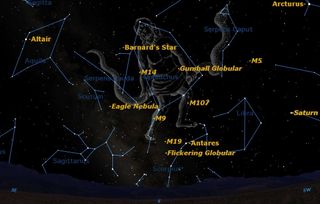Spotted! A Rarely Seen Constellation Shines This Summer

Although it is one of the largest constellations in the sky, Ophiuchus, the serpent bearer, is one of the least well-known. While large in area and prominent in the summer sky, it contains no bright stars, so it is rarely seen.
Ophiuchus is surrounded by brighter, more famous constellations. Boötes is to his right, the Summer Triangle is to his left, Hercules is above his head and Scorpius is at his feet.
For simplicity, I’ll describe the view from the Northern Hemisphere. Observers in the Southern Hemisphere will need to make the usual corrections. Like Orion, Ophiuchus is an equal opportunity constellation: on the celestial equator, he is equally visible everywhere in the world. [See Amazing Night Sky Photos by Stargazers (May 2013)]
An ignored constellation
Ophiuchus made the news a couple of years ago when astrologers finally acknowledged his existence. Even though astronomers have known about Ophiuchus for thousands of years, and that he literally sticks his foot into the zodiac, he has never figured among the astrologers’ 12 signs of the zodiac. Astrologers promptly made up a new set of imaginary qualities of "Ophiuchans," which of course are just as fanciful (and imaginary) as their other inventions.
If you look at the picture of Ophiuchus, you will see that he is apparently wrestling with a very large snake. This is represented by two constellations on either side of him, Serpens Caput (head of the snake) on the right and Serpens Cauda (tail of the snake) on the left. Although Serpens consists of two distinct areas of sky with Ophiuchus in between, it only counts as one of the 88 constellations.
This association with a snake links Ophiuchus to Asclepius, the ancient Roman healer in lore, who observed one snake bringing medicine to another snake. These snakes survive as the two snakes encircling the staff of Asclepius, symbol of medicine.
Get the Space.com Newsletter
Breaking space news, the latest updates on rocket launches, skywatching events and more!
Hidden stellar surprises
Ophiuchus is a constellation worth getting to know because it is full of interesting objects. In particular, because of its location just off the Milky Way, it contains a wealth of globular clusters, the ancient clusters of stars which orbit the center of the galaxy. In fact, there are no fewer than seven Messier globulars — clusters catalogued by the French astronomer Charles Messier — in Ophiuchus; only Sagittarius contains this many Messier globulars.
The finest of these globular clusters is Messier 12, sometimes known as the Gumball Cluster. It is easily spotted in a dark sky with binoculars, because there is nothing else like it in the open empty area in the middle of Ophiuchus except for its nearby twin, Messier 10. Look for two faint fuzzy patches. In a medium-size amateur telescope, both these clusters resolve easily into thousands of stars.
Ophiuchus’ snake also has its share of deep sky objects. Serpens Caput features Messier 5, one of the finest globular clusters in the sky, while Serpens Cauda contains the Eagle Nebula, Messier 16, famed for the Hubble Space Telescope’s iconic "Pillars of Creation" image.
There is one very special star in Ophiuchus. This was discovered by American astronomer E. E. Barnard in 1916 when he found it to be the fastest-moving star in the sky. It still holds that record to this day. It moves only about 10 arc seconds a year, about half the diameter of the planet Saturn, but that’s more than any other star in the sky.
Barnard’s Star moves that quickly because it is very near to the sun. In fact, after the three stars of the Alpha Centauri system, it is the nearest star to the sun at only six light-years away. Unfortunately, Barnard’s Star, as it came to be known, is a very dim red dwarf star, and so needs a telescope to be seen.
In a telescope, Barnard’s Star is a very ordinary-looking reddish ninth-magnitude star. But if you plot its position relative to nearby stars, and then go back in 10 years' time, you will find that it has moved noticeably. Even in photographs taken a year apart, it has moved slightly.
So, on one of these fine summer evenings, have a look at Ophiuchus, with his beautiful globular clusters and his fast-moving star.
This article was provided to SPACE.com by Starry Night Education, the leader in space science curriculum solutions. Follow Starry Night on Twitter @StarryNightEdu. Follow us on Twitter, Facebook and Google+. Original article on SPACE.com.
Join our Space Forums to keep talking space on the latest missions, night sky and more! And if you have a news tip, correction or comment, let us know at: community@space.com.

Geoff Gaherty was Space.com's Night Sky columnist and in partnership with Starry Night software and a dedicated amateur astronomer who sought to share the wonders of the night sky with the world. Based in Canada, Geoff studied mathematics and physics at McGill University and earned a Ph.D. in anthropology from the University of Toronto, all while pursuing a passion for the night sky and serving as an astronomy communicator. He credited a partial solar eclipse observed in 1946 (at age 5) and his 1957 sighting of the Comet Arend-Roland as a teenager for sparking his interest in amateur astronomy. In 2008, Geoff won the Chant Medal from the Royal Astronomical Society of Canada, an award given to a Canadian amateur astronomer in recognition of their lifetime achievements. Sadly, Geoff passed away July 7, 2016 due to complications from a kidney transplant, but his legacy continues at Starry Night.
